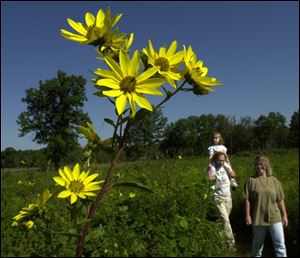
Reaping the bounty
9/3/2001
Kandace York leads Toledoan John King and his daughter, Lillian, 5, through Kitty Todd Nature Preserve.
The harvest is in full swing in Kitty Todd Preserve in Spencer Township, but there are no noisy tractors or big trucks on these acres to pick and transport the loads.
Instead, volunteers gathered an abundant bounty of wildflower seeds into small bags; the seeds will be potted and sold locally to give the native plants wider exposure to gardeners.
Plants like bergamot, a relative of the mint family, and New Jersey tea, a plant the Pilgrims and early settlers used as a substitute for English tea, yielded the seeds, said Kandace York, a spokesman for the Nature Conservancy, which owns and runs the 575-acre black oak savanna and wet prairie habitats.
“It was a good collection,” she said of the Labor Day weekend harvest. “I wouldn't say it was a record. But it is early in the season.” Earlier this year seeds of the wild blue lupine were collected. Wild grasses will be picked later this fall. “The critical thing is taking what is available, leaving some of the plant, and allowing nature to run its course,” she said.
About 20 volunteers who made the foray to the preserve on Old State Line Road gave nature a helping hand. Collecting the native seeds will be done again at 10 a.m. Sept. 15 and on Sept. 29.
The seeds are turned over to Portage Valley Plant Co. of Holland. Over the winter the company germinates the seeds, then sells the plants through more than a half-dozen retail nurseries. Plant sales from the project have grown steadily the last three years.
September is the optimum time to collect many wildflower seeds, Ms. York said. As the flowers mature, the seeds are suitable for picking for only a few days before they disperse.
In coming weeks, students in Mary Ellen Newport's biology class at Maumee Valley Country Day School will visit the preserve to help collect seeds. Her students will return in the spring to plant what they grew from seed.
“I am always impressed with how big their plants look in the spring,” Ms. York said. “They look very good, I think, because they have 25 to 30 students looking over them.”